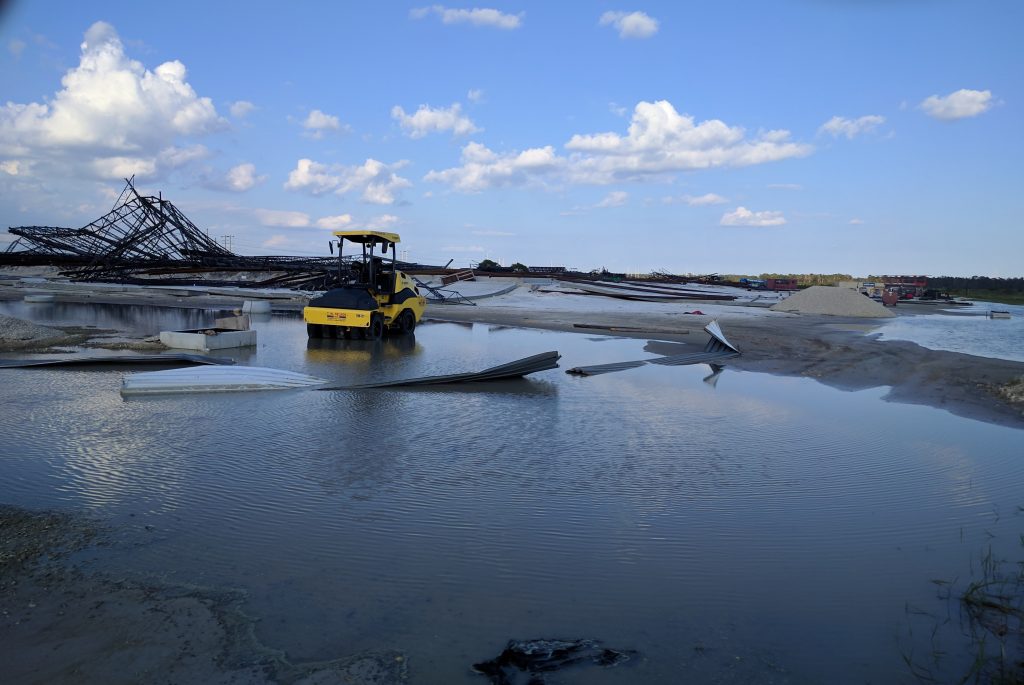
The cliché: “A picture is worth a thousand words” seems appropriate to describe the image of what became of the under-construction 125,000 sq. ft. Robb & Stucky International headquarters in Fort Myers after Hurricane Irma blew through Florida earlier in the month.
A local observer associated with the construction industry took these images, saying the tilt-up concrete construction methodology, while economical and certainly suitable for building long-standing hurricane resistant buildings, isn’t going to provide much storm protection while construction is in progress.
“Ironically the first time the job went out to bid it was over budget so they sent it back for redesign,” the picture-taker says in a note. “The redesign cut the square footage back a little bit but also delayed the construction start for a few months.
“Had it not been for that, in my opinion the building should have been along far enough to where it should have been able to withstand the storm.”

“Robb & Stucky is a furniture store that from this storm even more people are going to need furniture and they’ll need the warehouse space. I think, in the end the end, to start over, it will exceed the original bid and plus not having the warehouse space sooner will cost them in other ways.”
A representative of local contractor GATES Construction, which is the general contractor overseeing the project, didn’t respond to emails from Florida Construction News asking about the cost of the building/damage and the rebuilding process. (This lack of response should not be seen negatively – it is probable that the contractor’s business leadership has more pressing hurricane recovery concerns than to respond to media inquiries.)
Before the storm brought the under-construction building to ground, Eric Chien, a Robb & Stucky vice-president and its chief financial officer, told The Business Observer that the new building would be completed in December.

“As we’ve continued to expand, we’ve found that we need more space,” Chien told the business publication. “The first phase of this project will result in one central warehouse for all of our Florida stores, even as we add more stores in the future.
“Fort Myers is the center of our market,” he said. “The new building is also close to Interstate 75, so we will be able to go north or south to reach stores.”
The retailer has stores in Sarasota, Fort Myers, Coral Gables and Naples, and has a recently opened showroom in Boca Raton. It purchased the 16-acre headquarters site at 16311 Lee Rd. last year for $2.8 million.







It is unfortunate that news gets reported with quotes from “local observers” that demonstrate the lack of technical knowledge. There is no system in the marketplace that is “tilt-up masonry construction”. The building is being constructed with tilt-up concrete construction. Masonry is a construction method where individual pre-manufactured elements are cemented together with a mortar or dry-stacked and then secured with grout. Tilt-up construction is a system where monolithic panels of concrete are constructed on the ground and then lifted or erected to their intended position by a crane. The article is correct, that during construction the erected panels are vulnerable as they are supported on temporary braces designed to take a maximum wind load as defined by ASCE 7 and the TCA Wind Bracing Guidelines. Additional braces can be installed or designed for times of the year when storm exposure is greater, however. Once completed, the roof diaphragm and the panels work in tandem for all lateral and force-resistant stability. Until then, however, the structural system as designed by the engineer of record is not ready for such extreme forces.
Thanks for this comment. I’m sorry for the mis-designation of tilt-up concrete as “masonry” in the original version of this story. This has been corrected.